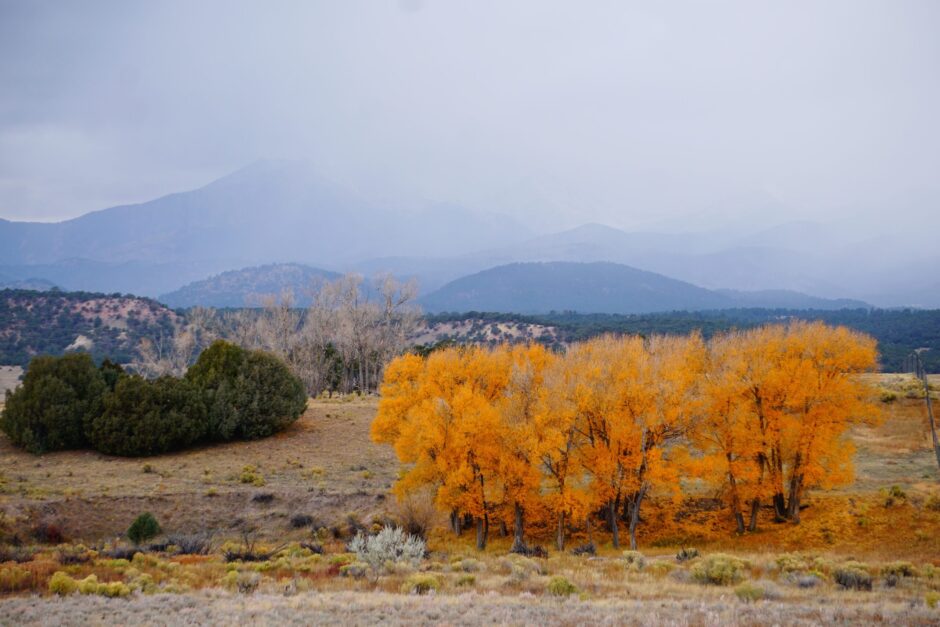Living in green & leafy Pennsylvnia part of the year, and (sometimes green) & (always) gorgeous Colorado the other part of the year, I notice how forest fires seem rather abstract for the East, a dreaded reality for the West. Timothy Egan’s nonfiction novel (my usage, I’ll admit) The Big Burn (2009) is a gripping, amazing book about forest fires, American history, the West, and a portent of things to come—as was his National Book Award-winning The Worst Hard Time (2006), about the Dust Bowl of the Great Depression. Here’s a quick excerpt:
“It felt as if the town was under artillery fire, the mile-high walls of the Bitterroots shooting flaming branches onto the squat of houses in the narrow valley below. Between flareups and blowups, the hot wind delivered a continuous stream of sparks and detritus. . . . Earlier in the day, ashes had fallen like soft snow through the haze. At the edge of town, where visibility was better, people looked up and saw thunderheads of smoke, flat-bottomed and ragged-topped, reaching far into the sky” (3).
The Big Burn focuses particularly on the catastrophic fires of 1910, centering the story in Wallace, Idaho, a town that was virtually engulfed and destroyed by the flames. It has a great beginning, situating the reader (in medias res, if we want to get Latin about it) at the moment just before Wallace is about to burn to the ground, then backstepping to the history of Teddy Roosevelt and Gifford Pinchot, the first head/originator of the U.S. Forestry Service, along with other key figures such as John Muir, the robber barons of the West, and even Grover Cleveland, who helped get the Forestry Service off the ground.
The recent fires near Boulder, Colorado, are unfortunately probably a Sign of Things To Come: As temps heat up, drier weather will prevail, and the only thing that keeps Colorado—and other parts of the West—from burning every summer is the summer monsoon rains, but those can fail, as they did most recently in 2002. I was there. It was freaky. Clouds would form and pass over. Hardly any rain fell for months. I think there was a county in Eastern Colorado that recorded less than one inch of rain over a full year. The Iron Mountain Fire, in my home area of Custer County, Colorado, destroyed over 100 structures. I saw people crying in the convenience store, ready to get payback on the yahoos who started the fire by walking away from an outdoor grill (banned at that time), which was then knocked over by gusty winds. Many of these people owned homes but had no insurance. And for all those who do pay for insurance annually, it makes your rates go up if they have to pay out claims (of course insurance companies raise rates for many other reasons as well, such as price gouging/fixing, but that’s another story).
Read The Big Burn. It’s a great book.
- October 2023
- September 2023
- September 2021
- April 2020
- September 2019
- May 2019
- August 2018
- February 2018
- January 2018
- October 2017
- August 2017
- June 2017
- May 2017
- March 2017
- February 2017
- November 2016
- October 2016
- May 2016
- April 2016
- March 2016
- February 2016
- January 2016
- November 2015
- October 2015
- September 2015
- June 2015
- May 2015
- April 2015
- March 2015
- December 2014
- September 2014
- August 2014
- May 2014
- March 2014
- February 2014
- January 2014
- December 2013
- November 2013
- October 2013
- September 2013
- August 2013
- July 2013
- June 2013
- May 2013
- April 2013
- March 2013
- February 2013
- January 2013
- December 2012
- November 2012
- October 2012
- September 2012
- August 2012
- July 2012
- June 2012
- May 2012
- April 2012
- March 2012
- February 2012
- January 2012
- December 2011
- November 2011
- October 2011
- September 2011
- August 2011
- July 2011
- June 2011
- May 2011
- April 2011
- March 2011
- February 2011
- January 2011
- December 2010
- November 2010
- October 2010
- September 2010
- August 2010
- July 2010
- June 2010
- May 2010
- April 2010
- March 2010
- February 2010
- January 2010
- December 2009
- November 2009
- October 2009
- September 2009
- August 2009
- July 2009
- June 2009
- May 2009
- April 2009
- March 2009
Recent Posts
- Aliens Among Us: Probing Hillbillies and Freaking Shut-ins, How Netflix’s “Encounters” and Hulu’s “No One Will Save You” Prep Us for the Coming Alien Apocalypse, Kind of
- My Life as a Bob Odenkirk Character: On How Watching Netflix’s Black Mirror episode “Joan Is Awful” Mimicked My Experience of Watching the AMC series Lucky Hank
- “Bobcats, Bobcats, Bobcats”: Animal Life and a Tribute to “Modern Family”
- “The North Water”: This Ain’t Your Daddy’s Moby Dick
- Day 25: On David Quammen's "Spillover": Terrific Book That Foretold Our Pandemic, Kind of
Recent Comments
No comments to show.
